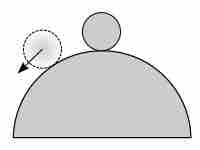For an object to be in static equilibrium, we expect it to stay in the same state indefinitely. If it starts accelerating away from its current position, it would hardly be in equilibrium. To quantify equilibrium for a single object, there are two conditions:
- The net external force on the object is zero:
$\sum_i \mathbf{F}_i = \mathbf{F}_{net} = 0$ - The net external torque, regardless of choice of origin, is also zero :
$\sum_i \mathbf{r}_i \times \mathbf{F}_i = \sum_i \mathbf{\tau}_i = \mathbf{\tau}_{net} = 0$
Those two conditions hold regardless of whether the object we are talking about is a single point particle, a rigid body, or a collection of discrete particles. Being in equilibrium means that we expect no changes to the linear momentum or the angular momentum. Note that this does not mean that the system is not moving or rotating; instead it simply means that its movement will not change as time goes on.
In a special case when the external forces are governed by some potential (e.g. gravitational potential) we can gain insight into the nature of the equilibrium. From the definition of a potential we know that
Mathematically, we can view this as a Taylor series expansion on the force slightly away from equilibrium,

Unstable Equilibrium
A ball on top of a hill can initially be balanced, but if it moves slightly left or right, it gets pushed further and further away from the initial equilibrium position. This is an example of unstable equilibrium.
Our notion of "balance" comes directly from the formulation of equilibrium. For something to be "balanced" means that the net external forces are zero. For example, a coin could balance standing up on a table. Initially the coin will feel no net external force or torque; it is in equilibrium. But if pushed slightly to the side, it will become "off-balance," experiencing both a force and a torque causing it to fall to the table. It might have been initially "balanced" and at equilibrium, but it was an unstable equilibrium, prone to being disturbed. But why all this talk of external forces, with no mention of internal forces? The reason is that all the internal forces must sum to zero. This follows directly from Newton's Third Law,
This differentiation between internal and external forces is a powerful one. It also implies that you can trace the motion of the system as a whole (ignoring motion inside the system) through the net external force acting on a center of mass. A center of mass acts as if it has the entire mass of the system, located at one point, and only feels external forces. Its position is defined as the weighted average of all the particles in the system: